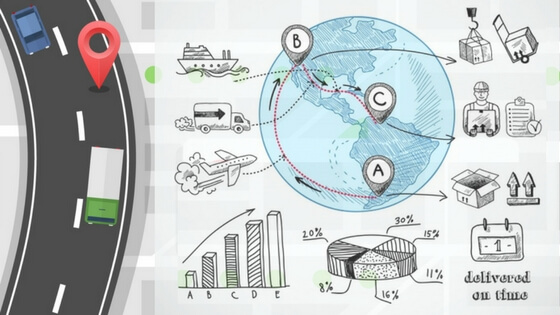In this day and age where technology has become the essence of everything essential in our lives, even the governments and people have woken up to its benefits. Modern traffic times have necessitated that the latest technology is used in the traffic systems as soon as possible. This is where Transync Gps Trackers come in to play where their high end AIS 140 Compliance devices that have some very unique features that sets them apart.
AIS 140 frames guidelines for the implementation of the Intelligent Transportation system in India. India is a country where public transport is still the main source of travel or any form of the commute for lakhs of people every day. Indian government has mandated that the guidelines should be implemented in the public transport section by April 2018.
There are some main points of the implementation which include:
• An emergency button in every vehicle accessible by the passengers and driver
• Camera surveillance of in order to monitor the driver behaviour as well as other aspects of the transportation travel
• A well advanced GPS system with are in compliance with the AIS 140 system in order to track the movement and as well as idle period of the vehicles. This will also be especially helpful in case of a mishap.
![]()
Transync Gps Trackers proved top of the range GPS AIS 140 compliance device which can provide accurate and real time tracking for the vehicles which is very precise and reliable. These GPS systems work with international technology and follow the code of GAGAN (India’s own navigation system) to give the accurate results. This GPS system is also accurate in analysing the driver behaviour which in turn improves the efficiency of the entire transport system.
Transync Employs some of the best minds in the industry today and in collaboration with the Automotive Research Association of India their research and development team has developed the most reliable and advanced AIS 140 complain vehicle telematics and emergency button solution. Transync understands the Indian driving conditions and even the driver and pedestrian behaviour. Ministry of Road Transport and Highways bought about a notification on 28th Nov 2016 which clearly states the compulsory requirement of installing monitoring devices in every new and existing vehicle.
Transync AGPS system has been developed with the future conditions road and public requirements and vehicle development in mind. The AIS140 asks for vehicle health monitoring, CCTV camera monitoring, and passenger information systems, emergency arrangements etc. The AGPS can effortlessly integrate itself with the other supporting devices which follow the regulation parameters. The system is easy to install and learn which makes it easier for the drivers to get a hang at the same time the devices are temper proof and the results cannot be altered unless done from the command center. Emergency alerts are sent out immediately if any unauthorized changes are made. In addition to the standard mandatory requirements Volty IoT’s AGPS also has the capability to integrate other important features such as risk management to minimize hazards and accidents, maintenance tracking and other diagnostic tools for driver help and safety. The data and records can be saved on the cloud platform for later analysis and better tracking. This means that the device offers better real time tracking, route mapping and driver behaviour monitoring at east.
There are three salient features of Transync AGPS devices which sets them at a level above the competition. These include
• Integrated AGPS in all AIS 140 compliance devices which ensures that the vehicle is never away from the monitoring centre’s monitoring which in turn means better security for the entire feel and public information system.
• Transync AIS 140 compliance devices are designed to withstand heavy load dumps. In simple ways it means that the device is protected from the heavy surges in the vehicle electrical system which is very common in the in the Indian vehicles.
• In extensive collaboration with the American insurance giant, Transync AIS140 compliance devices come inbuilt with diver behaviour analytics. This is the most important feature of the device because
- It helps increase the efficiency of the fleet
- Improves public satisfaction in them knowing that they are secure and monitored at all times and help will be on hand when the need arises
- Ensures regular vehicle maintenance by clocking the devices at regular intervals.
- The drivers are secure in knowledge that their schedules will be maintained and they will not be over worked and therefore have better faith in the system.
Transync has partnered with UBLOX technology to make use of their superior wireless technology which has helped further strengthen the AIS140 compliance. UBLOX is the global leader in manufacturing of the wireless communication modules and semiconductors for all kinds of markets. UBLOX is the world leader in GNSS technology which gives it the best understanding of all aspect of automotive industry and its requirements. Some of the salient features of the UBLOX and Volty IoT’s AIS compliance roadmap include:
- High accuracy among all IRNSS modules
- High sensitivity for greater accuracy
- Small devices which can be easily installed with only 17×22.4mm dimensions.
- First in market devices with 12 band and dual frequencies.
- Precision for up to centimetre level ensuring high availability of the devices.
- In built anti jamming and anti spoofing facilities to ensure that highest level of security is available.
- In case the transport is stuck in challenging situations dead reckoning option is available which very important features is as it means the current location of the vehicle can be tracked using the previous locations.
Who Needs AIS 140 GPS Tracker
AIS 140 Notification :
New Rule 125H of the Central Motor Vehicles Rules, 1989 Introduced
Ministry of Road Transport and Highways, Notification in Gazette of India Extraordinary Part II Section 3 Sub-section (i) bearing no. G.S.R. 1095(E). dated 28th November, 2016
“125 H. Provision of vehicle location tracking device and emergency button.-
(1) All public service vehicles, as defined under clause (35) of section 2 of the Act, shall be equipped with
or fitted with vehicle location tracking device and one or more emergency buttons:
Provided that this rule shall not apply to the following category of vehicles, namely:-
(i) two wheelers;
(ii) E-rickshaw;
(iii) three wheelers; and
(iv) any transport vehicle for which no permit is required under the Act.
(2) The specifications, testing and certification of the vehicle location tracking device and emergency button
referred to in sub-rule (1) shall be in accordance with AIS-140: 2016, as amended from time to time, till such
time the corresponding BIS specifications are notified under the Bureau of Indian Standards Act, 1986 (63 of
1986).
(3) The vehicle location tracking device and emergency button referred to in sub-rule (1) shall be fitted by
the manufacturer or their dealer or the respective operator, as the case may be, in accordance with AIS-140: 2016,
as amended from time to time, till such time the corresponding BIS specifications are notified under the Bureau
of Indian Standards Act, 1986.”.
AIS 140 Amendment Key Points :
Device Approval: Approval provided at Device level for compliance to this standard.
These approved devices can be fitted / retro-fitted by manufacturer/ dealer/permit holder/system integrator in any vehicle model provided it shall meet installation requirements as mentioned in Clause No. 5 of this standard. For manufacturers seeking vehicle level approval with approved VLT with Emergency Buttons fitted shall only require installation approval as per the provisions of Clause 5 and Sub-Clause 6.1 of Clause 6.
ITS FUNCTIONS AND REQUIREMENTS
The list of ITS functions envisaged from this device type is set out below in Table 3A –
| Table 3A: List of ITS Functions and Sub Functions | |
| Function | Sub Functions |
| Safety and Security | Emergency Buttons |
| Vehicle Location Tracking (VLT) | |
The above functions and their requirements shall be met by only single device that can be interfaced by external emergency buttons. The communications to Backend Control Server (Government authorized server) shall be done by device as per the protocol and functionalities defined below.
3.1 Vehicle Location Tracking (VLT) With Emergency Button
3.1.1 Functional Requirements for VLT
3.1.1.1 Device shall be capable of obtaining position information using Global Navigation Satellite System (GNSS). GNSS receiver specifications are as follows:
a. Device shall be capable for operating in L and/or S band and include support for NAVIC/IRNSS (Indian Regional Navigation Satellite System) for devices installed on or after 1st April, 2018.
b. The Device shall support GAGAN, the Indian SBAS (Satellite Based Augmentation System).
c. Device shall have a position accuracy of minimum 2.5 m CEP or 6 m 2DRMS.
d. Device shall have an acquisition sensitivity of minimum (-) 148dBm.
e. Device shall have a tracking sensitivity of minimum (-) 165 dBm.
f. Device shall have an internal antenna; however if in case of Integrated systems with vehicle / aftermarket OEM approved kits if the fitment location prevents the internal antenna from functioning, then external antenna shall be provided.
3.1.1.2 Device shall support standard minimum I/Os as mentioned: 4 Digital, 2 Analogue and 1 Serial Communication (e.g. RS232) for interfacing external systems (E.g. Digital input for Emergency request button
interfacing).
3.1.1.3 Device shall be capable of transmitting data to Backend Control Server (Government authorized server) via Wide Area (Mobile) Communications network (GSM/GPRS) as per Communication
Protocol in Section 4.
3.1.1.4 Device shall be capable of transmitting Position, Velocity and Time (PVT data) along with heading (direction of travel) to a Backend Control Server(Government authorized server) at configurable frequency as per
Communication Protocol of Section 4. The fixed frequency shall be user configurable, minimum frequency shall
be 5 sec during vehicle operation and not less than 10 minutes in sleep/IGN OFF) as per the protocol defined in Communication Protocol of Section 4.
3.1.1.5 Device shall be capable of transmitting data to minimum 2 different IP addresses (1 IP address for regulatory purpose (PVT data) and 1 IP address for Emergency response system other than the IP’s required for Operational purpose.
3.1.1.6 On pressing of Emergency button, the system implementing VLT function shall send emergency Alert (Alert ID 10 as mentioned in Sub-section 4.2.1 of Communication Protocol Section 4) to the configured IP address(s) as per the Communication Protocol mentioned in Section 4. In the absence of GPRS network, the emergency alert shall be sent as SMS message along with vehicle location data to configured control center number(s). The SMS shall consist parameters as given in Sub-section 4.2.2.
3.1.1.7 Device shall have an internal back-up battery to support 4 hours of normal operations (to be tested for positional record transmission at a frequency of 60 sec).
3.1.1.8 Device shall be capable of transmitting alerts to the Backend Control Server (Government authorized server) directly. The applicable list of alerts is given in Section 4.2 (Alert ID 3 to 12) of Section 4.
3.1.1.9 Device shall support over the air software and configuration update.
3.1.1.10 Device shall support basic standard configuration (Mobile communications network settings, Backend Control Server (Government authorized server) details, data frequencies, alert thresholds etc.) as per configuration specification defined in Section 4.
3.1.1.11 Device shall support store and forward mechanism for all type of data (periodic data and alerts) meant for backend transmission. The system shall store data in internal memory during communication network unavailability and transmit the data when the connection resumes in last in first out (LIFO) manner. The live data shall be given higher priority for transmission than back log (stored data) at any point in time.
3.1.1.12 The Device shall have a unique identifier for identifying the VLT device and data. The unique ID shall be stored in a read only memory area so that it cannot be altered or overwritten by any person. The unique identifier may be Vehicle Identification number or IMEI (International Mobile Station Equipment Identity) Number.
3.1.1.13 Device shall store/write the registration number of the vehicle in the internal nonvolatile memory.
3.1.1.14 Device shall have an Embedded SIM.
3.1.1.15 Device shall be designed to operate between 8VDC and 32VDC using vehicle battery input voltage range 12 /24Volts.
3.1.1.16 Device shall have a sleep mode current ≤ 20 mA (If the function is implemented in a dedicated system/device).
3.1.1.17 Device shall support any operational GNSS system with 12 (minimum) acquisition channels.
3.1.1.18 The Device shall support:
- Location on GPRS/SMS
- Non-volatile memory to store min 40,000 positional log
- Configurable backup SMS facility in case of GPRS failure
- Capability to send serving and adjacent cell ID as well as network measurement report (NMR)
3.1.1.19 The Device GNSS module shall have:
- The capability of Hot start <5s
- The capability of Warm start : < 30s
- The capability of Cold start < 40 s
3.1.1.20 Device shall support Outputs as per NMEA 0183
3.1.1.21 The Device GPRS module shall have:
- Multi slot GPRS with In – built Quad-band GPRS module/Modem
- GPRS class 10 or above
- Support Embedded SIM to cater to the automotive operational requirement such as vibration, temperature and humidity and provide long life span with at least 10 years life and more than 1 million read/write cycles
- GPRS module & SIM shall support
- SMS, Data (GPRS, TCP/IP) and
- Support multiple network OTA switching (on-demand/automatic)
capabilities.
3.1.1.22 Device shall be dust, temperature, vibration, water splash resistant, IP 65 rated or better, tamper proof as per Section 6.
3.1.1.23 Device shall be manufactured using processes as per quality management standard for automotive industries i.e. ISO/TS 16949 updated from time to time.
3.1.1.24 Device shall support A-GPS (Assisted GPS).
3.1.1.25 Device shall have provision of secured data transmission to the Backend Control Centre from the devices through secured channel (e.g. secured dedicated APN).
3.1.1.26 Device shall have 3 axis accelerometer and 3 axis gyroscope for getting the alerts on harsh breaking harsh acceleration, and rash turning.
3.1.2 Functional Requirement for Emergency System
3.1.2.1 Passengers or in-vehicle crew present in the vehicle shall be able to make an emergency request by pressing the emergency button provided.
3.1.2.2 The emergency request function shall not exist as standalone. The function shall be part of Vehicle Location Tracking (VLT) system. An alert shall be sent to the Backend Control Server (Government authorized server) when emergency request is raised. De-activation shall always be from authorized government server who receives alert message i.e. NERS system as mentioned in Sub-section 4.2.2.
3.1.2.3 The Emergency Buttons will be ‘Normally Closed’ (NC) type. The form factor of Emergency Buttons will be such that the button is easy to press in the case of an emergency, and simultaneously also minimizes the possibility of accidental or unintended press thereby causing a false alert.
3.1.2.4 On pressing of Emergency button, the system implementing VLT function shall send emergency Alert (Alert ID 10 as mentioned in Subsection 4.2.1 of Communication Protocol Section 4) to the Backend Control Server (Government authorized server) as per the Communication Protocol mentioned in Section 4. In the absence of GPRS network, the alert shall be sent as SMS message along with vehicle location data to configured control center number. The SMS shall consist of parameters as given in Sub-section 4.2.2.
3.1.2.5 In absence of both GPRS and GSM networks and on pressing of Emergency Button, the system implementing VLT function shall store the emergency Alert (Alert ID 10 as mentioned in Sub-section 4.2.1 of Communication Protocol Section 4). Once the GPRS or GSM is available, this alert information shall be sent on high priority to the configured IP addresses as per the communication protocol mentioned in Section 4 or as SMS message along with vehicle location data to configured control center number. The SMS shall consist of parameters as given in Sub section 4.2.2.
3.1.3 Configuration of Device Parameters Over the Air (OTA) The device shall support at least the below parameters to be configurable over the air (through SMS and GPRS). The updation shall be allowed only over an ‘authenticated’ channel:
1. Setting/ Change of the Primary or Secondary IP and port number
2. Setting/ Change of the APN
3. Set configuration parameter like sleep time, overspeed limit, harsh
braking, harsh acceleration, rash turning threshold limits etc.
4. Emergency control SMS Centre Number(s)
5. Configuring the vehicle registration number
6. Configuring the frequency of data transmission in normal / Ignition
state / OFF state sleep mode/ Emergency state, etc.
7. Configuring the time duration for Emergency state
8. Capability to reset the device
9. Command to get the IMEI of the device
Configurable commands must involve the following features:
- SET: For setting the parameters.
- GET: For enquiring regarding the parameters such as mobile number,
GSM strength, vehicle number and other important parameters. - CLR: For clearing certain commands, alarms, alerts etc.
After each SET, GET, CLR command the device should send alert toBackend Control Centre, as mentioned in Section 4 Alert 12, giving the details of Mode, mobile no/ IP of control center sending commands.
Volty IoT’s CEO recently address the press and said. “We are very proud to work in association with the Ministry of Road Transport and Highways to ensure road safety for all. Development of the Intelligent Transport systems is our contribution as a support to the government initiative. We have worked towards fulfilling the AIS-140 regulations and to make it a revolution in making the public transport system in India reliable and safer for one and all”


